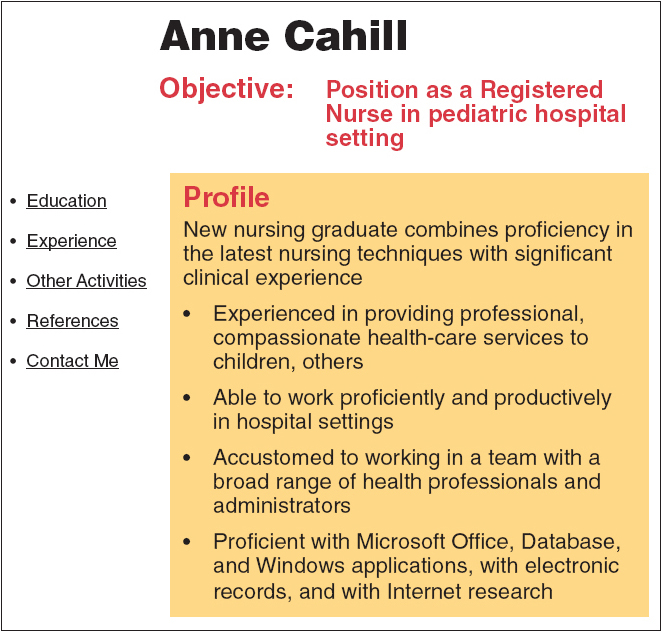Résumés
For more on résumé format and another student sample, see the Quick Format Guide beginning on p. A-1.
In a résumé, you present yourself as someone qualified to excel at a job and be an asset to the organization. Job seekers often have copies of a single résumé on hand, but you may want to customize yours for each application if you can easily print attractive copies. Either way, keep it to one page unless you have extensive relevant work experience.
A résumé is highly formatted but allows many decisions about style, organization, and appearance. A typical résumé consists of a heading and labeled sections that detail experience and qualifications. Highlight labels with underlining, boldface, or larger type. Within a section, use brief, pointed phrases and clauses, not complete sentences. Use action verbs (supervised, ordered, maintained) and active voice whenever possible. Arrange information to please the eye; use the best paper and clearest printer you can. (See Figure 17.1.)
For electronic applications, you may need a résumé in several forms: a text file for attaching to an e-mail, an electronically readable version for a company to scan into its database, or a Web version for posting on your site or a job site (see Figure 17.2). Format these versions carefully so that recipients can easily read what you supply. Turn to your campus career center for résumé samples and advice about alternate formats.

Uses clear and direct heading
Organizes menu of available information
Creates professional Web design using bullets, color, and white space

Heading. The heading is generally centered (or otherwise pleasingly aligned) on the page with separate lines for your name; street address, city, state, and zip code; phone number; and e-mail address.
Employment Objective. This optional section allows personnel officers to see at a glance your priorities and goals. Try to sound confident and eager but not pompous or presumptuous.
Education. This section is almost always included, often first. Specify each postsecondary school you’ve attended, your major, your date of graduation (or expected graduation), and your grade point average (if it reflects well on you). You can also add any awards, honors, or relevant course work.
Experience. In this key section, list each job, most recent first. You can include full- and part-time jobs. For each, name the organization, your position, your responsibilities, and the dates you held the job. Describe any involvement in unusual projects or responsibility for major developments. Highlight details that show relevant work experience and leadership ability. Minimize information unrelated to the job you’re seeking.
Skills. List any special skills (data processing, technical drawing, multiple languages) that aren’t obvious from your education and work experience.
Activities. You can specify either professional interests and activities (Member of Birmingham Bricklayers Association) or personal pursuits (skiing, hiking, needlepoint) showing that you are dedicated and well-rounded.
References. If a job advertisement requests references, provide them. Always contact your references in advance to make sure they are willing to give you a good recommendation. For each person, list the name, his or her organization and position, and the organization’s address and phone number. If references have not been requested, you can simply note “Available on request.”
As you prepare your résumé, and possibly your professional Web site, also consider your electronic trail and workplace etiquette. A future employer may well assume that anything you write at work is company correspondence, without personal rights to privacy, and that anywhere you travel online at work will represent or be subsidized by the company. That same employer is unlikely to be amused by your confessional Facebook page or your party photos. Though you might consider social-networking materials personal, they may seem very public to an employer who checks your background and your credibility. Your electronic presence should correspond with the reliable-future-employee presence you wish to project.